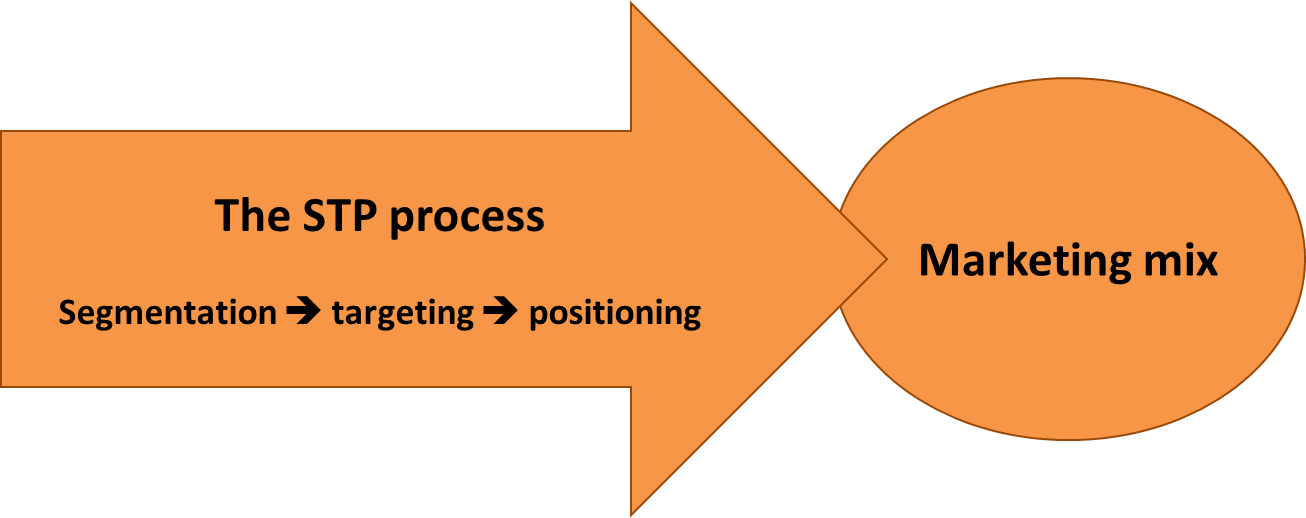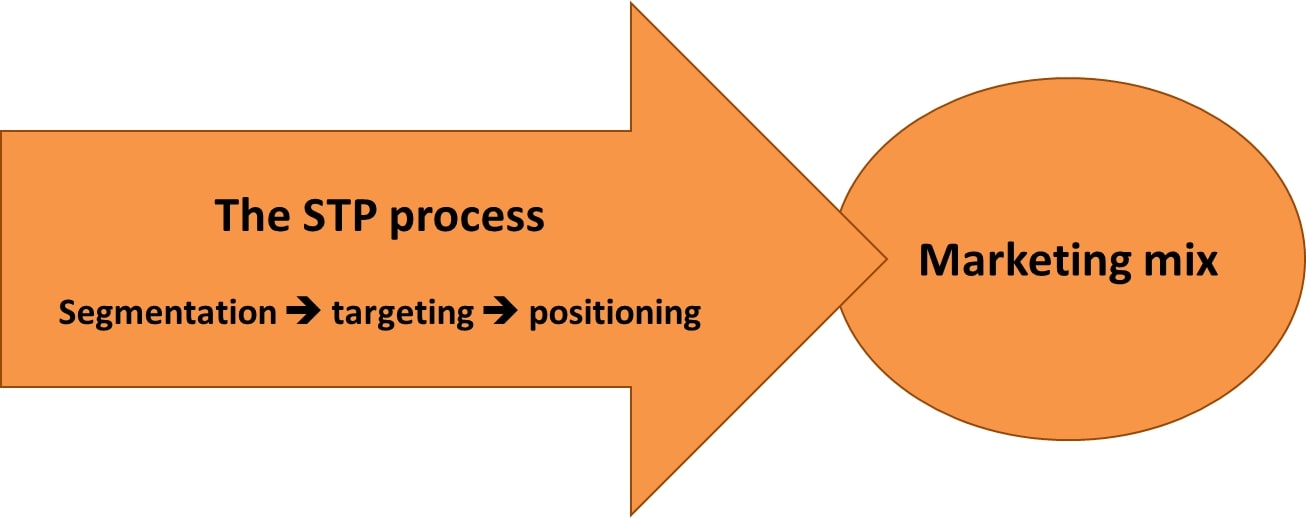STP Marketing Model: Definition, Role, Examples, Pros & Cons
Currently, many businesses are contemplating their marketing model for their marketing strategy. Do you have one? Is it effective?
In this post, we’re sharing the most simple yet effective framework for developing a marketing strategy-STP Marketing Model: Segmentation, Targeting, and Positioning Model. Apply this framework to your business and see how it transforms your life.
Related Posts:
- How Marketing Mix Modeling Can Help Marketers Achieve Great Results?
- 5 Types of Market Segmentation with Examples
- What is Interactive Marketing? Pros, cons, and examples
What is STP marketing?
The STP Marketing Model (Segmentation, Targeting, Positioning) is a framework that simplifies the market segmentation process.
By segmenting your market into groups, targeting the right groups, and positioning your products and services towards those groups, your marketing will be far more effective.
A current product should not target everyone as its customer. There is no such thing as one size fits all. Even a company like Coca-Cola, which runs in more than 200 countries and sells well above one billion people a day, provides multiple products to satisfy different groups of people.
Assuming that anyone can be a customer is a common mistake among many businesses. Going this route can make selling your product or service challenging as no potential customers will feel like your product is customized to them and their needs.
To make sales easier, you can employ the STP marketing model to classify your market into segments, choose the most potential segments, and then be the most desirable to your target segments by positioning your product or service.
Read more:
- A Deep Insight into Marketing Mix Modeling
- 8 Best Ecommerce Marketing Strategies
- Advanced Content Promotion Strategies
- What is Interactive Marketing?
Segmentation, targeting, positioning definition
Market segmentation is the process of dividing a market into smaller groups with similar product needs or recognizable features to choose suitable target markets.
Targeting, or target market selection, is all about a business’s proactive determination of an appropriate market segment (or segments) to massively direct the marketing offers and activities of the company towards this group of related customers.
Positioning or sometimes called product positioning, is the perception by the target market of the company’s main advantages and functionality compared to competitive product offerings.
The STP model example
Market Segmentation

You want to find potential customers in marketing, and persuade them to buy. You are also engaged in persuading former customers to become regular ones. To do this, you can offer products and services that satisfy their needs and wants. It involves making your value proposition known to the right audience.
Even though not everyone is the same, people are inclined to having the same interests as others. You need to define those similarities in the most specific and precise ways as possible. Such categories are called niches.
You can use segmentation to determine niches with particular needs and desires that you can clearly explain. In mature markets, segmentation can help you to find new customers. Segmentation enables you to adjust your messaging and get it across more effectively.
Marketing messages should be structured to answer and notify each segment about the most important benefits and features for that segment. This strategy is distinct from mass marketing, where one size fits all for all forms of consumers. This approach is more powerful and predictive because it provides the right mix to the right group of people, instead of a spray-and-pray shotgun approach.
Markets can be broken into smaller parts according to any variable, provided that you can clearly define and measure it. Below are some examples:
Demographics

It is the most common way of classifying individuals. You can do this based on the following aspects: geography, age, gender, income, education, ethnicity, marital status, occupation, or career. Demographics clarify who your customer is.
Psychographics

Psychographics dive deep into ‘why’ your customer buys. It is a way of grouping behavior based on personality and emotional characteristics that are associated with buying decisions. Psychographics involve attitudes, lifestyle, hobbies, personality, leadership traits, and attitudes toward risk.
Collect data through interviews, surveys, questionnaires, customer data, and feedback to help create psychographic profiles for your typical customers. It is the type of information Facebook collects, depending on “likes.” Develop the customer segments archetypes according to their psychographic profile.
You can buy and access vast data troves from internet, web, and mobile sources about the preferences and attitudes of prospective customers.
Lifestyle

Lifestyle is all about non-work time activities such as hobbies, recreational activities, leisure, vacations, etc. Keywords and search terms used in tools like Google Adwords will help you identify and approach potential customers by their interests and preferences in lifestyles.
To research these behavioral niches, you can take into consideration using Reddit, where like-minded people form subReddits about a specific interest or hobby. This effective way can help you a great deal in gaining a better understanding of customer segments with the shared information.
Belief and Values

The beliefs and values are religious, political, nationalistic, and cultural. Facebook and Twitter are the two dominant social media platforms to gather information.
Life Stages

Depending on people’s age, they tend to change and prefer different activities and have different interests. The groups of a twenty-year-old are different from those of a 60-year-old. Life stages are the benchmarking of the lives of people for different chronological stages.
Geography

Geography refers to where you locate people by country, region, area, zip codes, metropolitan or rural location, climate or mountains, and many more.
Language

With freely available translation tools like Google and Bing, targeting different language groups is fairly simple.
Behavior

Behavioral economics explores the impact of psychological, cognitive, emotional, cultural, and social variables have on people’s economic decisions.
In segmentation, it means how a consumer responds to the nature of the purchase, the brand loyalty, the level of use, the benefits sought, the channels of distribution used, and the response to marketing messages. Amazon has been studying the collection of this data to build customer profiles.
Usage level

Usage is an interesting variable. Many companies recognize that they have “power users” that represent an outsize portion of sales. Coca Cola, for example, has a club for their power users because they estimate that 20 percent of their customers account for 80 percent of their sales. Determine and exploit your power users.
Targeting

The following list refers to different criteria for determining each segment’s potential commercial viability.
Size

To justify segmentation the market must be big enough. Market potential size has expanded with the emergence of Long Tail markets. Long-tail applies to web-based markets where there is no geographical focus but intense interest is widespread around the world. Include all those loners and they may reflect important markets. The more peculiar your product the more you are going to market throughout geographical areas.
Difference

Segments should be easily recognizable and unique. There must be quantifiable differences between them. Measuring methods and techniques have flourished with digital marketing. Google Analytics is an incredibly valuable tool.
Money

In terms of money, it has got to be economically worth this. The estimated incremental profits must be greater than the additional marketing costs. The cost of a customer’s acquisition (CAC) must be less than their purchasing lifetime value (LTV). CAC< LTV
Accessibility

Potential consumers in each segment must be able to receive the marketing messages, and distribution networks and access them.
With the emergence of web and mobile messaging, digital downloads, SaaS models, and overnight delivery, accessibility has greatly improved. Different segments react to different advantages, thus, concentrate on communicating the different advantages.
Positioning

Positioning maps the variables explained in the segmenting and targeting steps and describes the place where your offering stays relative to competitors in the eyes of your customers.
Positioning is an aspect of branding. Insightful positioning is important when it comes to observing a competitive edge in the market. The perceptions and feedback of consumers affect the positioning of a brand in the market.
Functional, symbolic, experiential are three types of positioning that influence a brand and its competitive edge.
Functional Positioning
It is all about feature sets and user experience concentrating on the value proposition’s aspects that aim to satisfy and fulfill the needs and wants of customers.
Symbolic Positioning
Symbolic positioning has to do with luxury and prestige brands, which are idealistic components of your offering and the brand’s characteristics that satisfy your customers’ self-esteem.
Experiential positioning
Another element that contributes to the brand positioning is experiential positioning. Experiential positioning investigates the elements of a brand that approach customers’ emotional connection.
As a conceptual tool, positioning can help you to tailor your value proposition and get it across to customers. You need to emphasize your significant values that are distinct or superior to your competitors and convey this uniqueness to your customers the most satisfactorily.
The role of STP marketing model
The STP process represents an important concept in marketing study and application. The STP letters are for segmentation, targeting, and positioning. The STP is a basic concept for marketing success because companies would have fairly similar marketing approaches without it, and would, therefore, struggle to compete effectively.
The steps in STP are generally considered as a process, with first the segmentation, then the identification of one or more target markets, and then eventually the positioning implementation.
While the STP letters illustrate three critical marketing concepts, they are one linked process and function together to create a top-level marketing approach, which is then implemented by the marketing mix. The STP process aims to direct the company towards the development and implementation of an effective marketing mix, as seen in the diagram below.

As indicated by the diagram above, the overall STP process aims to improve the design of the marketing mix for the company. More specifically, the design of the marketing mix together establishes the positioning of the product which in turn attracts the target customer market.
The STP elements and process address several important questions in marketing for the company, like where to compete. The answer is market segmentation and then choose the target market. How could one compete? It is the positioning strategy and the application of a productive marketing mix.

From the diagram above, the STP marketing process for an organization is continuously defining the marketing strategy decisions. The company has to understand at first what market they participate in – which is answered by segmenting a given market.
The role of market segmentation facilitates the identification of desirable and profitable markets, which then enable the company to further fine-tune its strategic decisions and address the question “where to compete? “And the final element of the STP process is to determine an ideal product or brand positioning within the defined target market – which addresses the” how to compete?” question.
Advantages and disadvantages of STP marketing model
Advantages of STP marketing model
STP marketing model enables you to boost sales by determining a specific target market and then positioning products right at these segments. With this helpful model, you can also spot gaps in the market.
Besides, you can also avoid wasting money when advertising to the mass market. With the STP marketing model, small businesses and startups can work things out in niche markets as the competition with the bigger whole-market players is challenging to them.
Disadvantages of STP marketing model
If you are obliged to manufacture various versions of your product or service, then costs will increase. You will be required to develop different marketing campaigns and collateral for each segment you choose to target. This again raises your costs. To reach different customer segments, different distribution channels are required.
How to apply the STP model in your organization
Follow the steps below to apply the STP Model in your organization.
Step 1: Segment Your Market
Your business, product, or brand can not serve all people. Thus, market segmentation is important to classify your customers with similar characteristics and needs. By doing this, you can tailor your approach to meet the needs of each group the most economically, and you can have a significant competitive edge over rivals who use a “one size fits all” approach.
As mentioned above, to segment your target markets, you can take into consideration the approaches like demographic (personal attributes like age, marital status, gender, ethnicity, sexuality, education, or occupation), geographic (country, region, state, city, or neighborhood), psychographic (personality, risk aversion, values, or lifestyle), or behavioral (the way the customers use the product, how loyal they are, or the benefits that they are seeking for).
Step 2: Target Your Best Customers
The second step is to select which segments to reach by identifying the most appealing ones. You can take into account some factors here. First of all, consider each segment’s profitability and find out which customer groups make the most significant contribution to your bottom line.
The second factor you need to take into consideration is each customer group’s size and potential growth. Find out whether the audience size is big enough to be worth serving and the steadiness of the growth. And determine how it is compared to other segments. Guarantee that your revenues will not be affected when you shift your focus to an incredibly small niche market.
Another consideration is about how well your organization can serve this market. For instance, think about any legal, technological, or social barriers that matter. To evaluate the opportunities and threats that may influence each segment, you can carry out a PEST Analysis.
You will have to invest a lot of effort to target a segment effectively, thus, you should select only one segment to concentrate on at any given time.
Step 3: Position Your Offering
The final step is to position your product to target the most potential customer segments. Next, you can choose the most effective marketing mix for each of them.
First thing first, take into account the possible reasons that your customers should buy your product instead of those of your competitors. To do this, you can determine your unique selling proposition and draw a positioning map to learn how each segment perceives your product, brand, or service. The positioning of your offering will be much more effective.
Another element is each segment’s wants and needs, or the pain points that your product address for these individuals. Generate a value proposition that articulates how your offering will satisfy this demand better than the products of any of your competitors. After that, develop a marketing campaign that presents this value proposition in the most appealing way to your audience.
Related posts:
- Beats By Dre Marketing
- Chipotle Marketing Strategies
- Disney Marketing Strategy
- Heineken Branding Strategy
- Toms Shoes Marketing Strategy
Summary
To sum up, the STP marketing model is an effective framework including guidance for your marketing plan’s implementation. This framework makes sure that you are communicating the right content to the right audience, via the right channels, at the right time to accomplish your business goals.
If you want to measure how much marketing inputs affect sales or marketing share, you can adopt a Marketing Mix Modeling technique. For further information, we recommend you check out this post: A Deep Insight into Marketing Mix Modeling.
If you have any questions, do not hesitate to leave a comment in the box below. We are glad to help you out. If you find this post useful, you can share this with your friends.
New Posts






